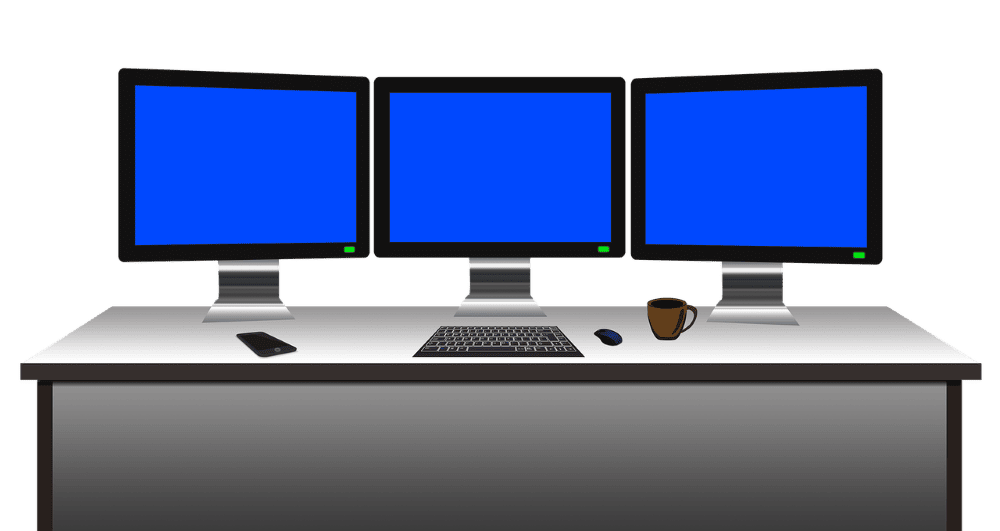Irrespective of whether you use a laptop or tablet privately or a fully-fledged PC for your daily work – time and again the desktop is pushed to its limit. Originally, consistently offered and developed especially by Linux, all common operating systems nowadays provide the so-called virtual desktop as a solution. Here, you can read what it’s all about – explained simply and clearly.
What is a Virtual Desktop?
With all common operating systems, the desktop has nowadays established itself as an effective and well laid-out tool for both home and work use. Similar to a desk, the desktop offers everything needed for day-to-day work on a computer. Just like the drawers of a desk, you can access files and submenus from a desktop, start a desired programme or file documents. The less space a desktop offers and the more it is used for working, the quicker it is pushed to its limits regarding size. This can quite quickly become the case with tablets, so called subnotebooks or sometimes also laptops. But even real PCs with large monitors reach their limit regarding their dimension when using various software applications. A solution is a so-called virtual desktop. Initially this term may confuse as even the ‘normal‘ desktop of an operating system is always only available virtually. Here something else is meant. If the desktop visible on the screen area is no longer sufficient, this will be expanded virtually in its size. Hereby, virtual refers less to the general display on a software basis, but that the expansion of the desktop is initially outside of the visible area. Aspects of the desktop, which are currently not required and cannot find space on the visible desktop surface, can then be stored in the virtual expansion of the desktop.
How a Virtual Desktop Functions
Depending on the operating system, there are different methods to access the currently non-visible areas of the virtual desktop. A well-known form is the simple switch of the desktop surface sideways or in vertical direction. Similar to the modification of a picture detail at Google maps or other graphic applications it allows to access the required desktop area quickly and easily. A modification of this form is scrolling to additional “pages” of the desktop. In contrast to a free shift as in the method previously described, here one shifts to a completely new view of the desktop. This switch is either done in a linear way, i.e. comparable to browsing in a book, or there is the option to leave the desktop in any direction – horizontally as well as vertically – to a new view. A graphical variant of this browsing is the desktop dice. Here various desktop views are arranged virtually in a three-dimensional form into a dice. Depending on the desired view, the required side of this dice is turned forward towards the screen. Ultimately, all these options are nothing more than certain types of graphical representation of one and the same principle to access an expansion of the desktop. Depending on what a virtual desktop is to display on its expansion area, individual representation variants can increase clarity and facilitate work.
Advantages and Disadvantages of a Virtual Desktop
When considering the functionality, it is obvious what advantages and disadvantages a virtual desktop brings:
| + | Expansion of the operational desktop through virtual desktop |
| + | Possible relocation of elements currently not required |
| + | Division of tool bars etc. with comprehensive software applications with large display range |
| + | Greater clarity per desktop pane providing options to sort or relocate |
| – | Threat of a loss of overview with an increasing number of desktop cut-outs |
| – | It is only suitable for applications with a large display area, if individual elements such as tool bars can be clearly defined and hence relocated. |
A Virtual Desktop is Aimed at this Target Group
A virtual desktop is primarily aimed at two user target groups. Thereby, it is irrelevant if it is for private or work use. Firstly, the offer of virtual desktop extensions is addressed to people, who work with particularly expansive programmes and therefore simply require more space for the display. Examples are comprehensive spreadsheets, but with even more widespread graphical applications. Here tool bars, which are not needed at present, can be moved easily sideways into an adjoining desktop area. If required, access can simply be established by a shift in the relevant direction. Secondly, a virtual desktop also offers advantages to those people who simply have too small a device for the display. In particular the growing segment of devices, which are positioned in between real laptops and smartphones in the grey area of tablets quickly reach their limit due to their small screen dimensions and limited resolution. In addition, a virtual desktop creates additional space for higher clarity or actually enables for the first time the use of certain applications.
Conclusion – Work more Flexibly with a Virtual Desktop
A virtual desktop creates space and higher clarity. In particular small end devices reach their limits quickly without these virtual extensions. When in use, it is important to implement a consistent system, otherwise with the increasing number of visual ranges it is easy to lose a sense of direction. After all, we all know the unpleasant position of not being able to find something on an overcrowded desk.
Image sources:
- Image 1: © mediamodifier | pixabay.com
- Image 2: © JanBaby | pixabay.com
- Image 3: © geralt | pixabay.com


